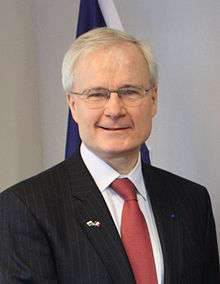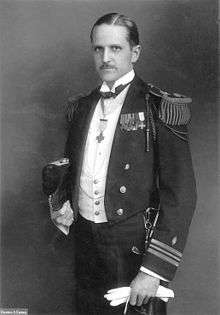Honour medal of Foreign Affairs
| Honour medal of Foreign Affairs | |
|---|---|
|
Honour medal of Foreign Affairs | |
| Awarded by the Ministry of Foreign Affairs | |
| Country |
|
| Type | Medal |
| Eligibility | French and foreign nationals |
| Status | Currently awarded |
| Statistics | |
| Established | Type 1 award 28 July 1816 – Type 2 award 30 August 2010 |
|
| |

Known for a long time as the President’s medal, the Honour medal of Foreign Affairs (French: "médaille d’honneur des affaires étrangères") is a state decoration bestowed by the French Republic in the form of an honour medal for work. It was originally created by a Royal decree of 28 July 1816 as a single grade medal to reward acts of courage displayed by French nationals on foreign soil.[1] An 1861 Imperial decree saw it be split into the silver and gold grades.[2] The year 1887 saw the addition of swords to the medal for award to both French or allied military personnel for acts of courage in favour of the French in time of war.[3] Although still bestowed in wartime for courage, the modern award is now aimed at rewarding civil servants of the ministry for Foreign Affairs.
Award statute
Currently, the Honour medal of Foreign Affairs is intended to reward honorable service by French diplomats and civil servants stationed outside of France. It can also be awarded to French nationals and foreigners for exceptional service to France or that have accomplished acts of courage in assistance to French nationals either in peace or wartime. Military awards are often bestowed on order of the French president, hence the common practice of calling it the President’s medal.[4] President Raymond Poincaré bestowed many such medals to French and foreign nationals during World War I.[4]
The Honour medal of Foreign Affairs is currently divided into three grades, bronze, silver and gold. When awarded for service, the bronze grade is awarded for no less than 20 years of service, the silver grade may be awarded a minimum of eight years later, the gold grade, seven years after the silver.[5]
The Honour medal of Foreign Affairs may be exceptionally awarded regardless of seniority and set quotas to reward bravery and dedication.[5] It can be awarded, also regardless of seniority and set quotas, if the recipient was wounded or killed in the line of duty.[5]
The wartime award with swords is bestowed as follows:
- In bronze to privates;
- In silver to non-commissioned officers;
- In gold (silver-gilt prior to 2010) to officers.
Award description
The Honour medal of Foreign Affairs, a design of engraver Daniel Dupuis,[4] is a 27mm in diameter circular medal in bronze, silver or gold. The obverse bears the relief effigy of the republic surrounded by the relief inscription "RÉPUBLIQUE FRANÇAISE" (English: "FRENCH REPUBLIC") along the left and right circumference. The reverse bears a crown of half laurel and half oak leaves with the relief inscription "AFFAIRES ÉTRANGÈRES" (English: "FOREIGN AFFAIRS") with a bare center destined to receive the recipient’s name and year of award.[5]
The medal hangs from a silk moiré tricolour ribbon composed of three equal blue-white-red vertical stripes.[4] The wartime award includes a wreath of oak leaves with two crossed swords on the suspension ring.[4]
Partial recipients' list for acts of courage and devotion

Gold grade:
Silver grade:
- Mr Walter ARNAUD[6]
- Mr Richard BEAUX[6]
- Mr Philippe BERJONNEAU[6]
- Mr Francky BLANDEAU[6]
- Mrs Isabelle du BOIS de MEYRIGNAC[6]
- Mr Vincent CORBEAU[6]
- Mr Vincent FALCOZ[6]
- Mr Jean-Marc FIORENTINI[6]
- Mrs Julie FORT[6]
- Mr François GARCIA[6]
- Mrs Mathilde de GERMAIN[6]
- Mr Cédric GRAS[6]
- Mrs Sophie LAFITTE[6]
- Mr Jérôme MALLARD[6]
- Mr Guillaume NARJOLLET[6]
- Mrs Agnès NKAKE[6]
- Mr Pascal NOJAC[6]
- Mrs Sylvie NOJAC[6]
- Mr Gérard NOUBEL[6]
- Mr Cédric PELTIER[6]
- Mr Eric TOSATTI[6]
Bronze grade:
- Mr Thierry BINOIST[6]
- Mrs Marie-Amélie DELAROCHE[6]
- Mrs Annick DORIS[6]
- Mrs Françoise DUBREUIL-KRIKORIAN[6]
- Mr Emmanuel FABRY[6]
- Mr Daniel FARBAT[6]
- Mr Jorge FERNANDEZ[6]
- Mr Pascal GEHANT[6]
- Mr Thierry MAIRE[6]
- Mrs Claire MALANDAIN[6]
- Mr Yann MILLET[6]
- Mr Frédéric PECH[6]
- Mr Marc RASTOLL[6]
- Mrs Corinne SIDIBE[6]
- Mrs Martine THEMIN[6]
- Mr Jean-Christophe THIABAUD[6]
Partial recipients' list for service to civil servants

Gold grade:
- Mr Arnaud BALNER[7]
- Mrs Mathilde de CALAN[7]
- Mrs Christine FAGES[7]
- Mrs Leslie GOLDLUST[7]
- Mrs Catherine HYVER[7]
- Mr Bertrand LE ROUX[7]
- Mr Alain RICHEZ[7]
- Mr Christophe SCHMITT[7]
- Mr Mounir SLIMANI[7]
- Mr Clément TARON-BROCARD[7]
- Mr Guillaume VELUT[7]
Silver grade:
- Mr Nicolas BARNAUD[7]
- Mr Rémi COTTIN[7]
- Mrs Pauline DELAPORTE[7]
- Mr Rémi DROUIN[7]
- Mr Julien MARIANI[7]
- Mr Jean-Baptiste POHL[7]
- Mr Odoric PORCHER[7]
- Mrs Candice VERLOT[7]
Bronze grade:
- Mr Smaïl CHAOUI[7]
- Mr Dimitri DEMIANENKO[7]
- Mr Guillaume GRELAUD[7]
- Mr Fabrice GROSSIR[7]
- Mr Rodolphe MONNET[7]
- Mr Guillaume PEGHAIRE[7]
- Mr Mickaël PITHON[7]
- Mr Arnaud ROLLAND[7]
- Mr Gwenn VALLEE[7]
- Mr Philippe VUYLSTEKE[7]
Partial recipients' list to foreign military personnel

In October 1917, the design of the crossed swords on two sprays of oak leaves changed.[8] The medal ranked after the Croix de Guerre and several were awarded to service members of Allied forces, including personnel from:
- United Kingdom (partial list)
- Sergeant-Observer William James Middleton, Royal Air Force. Silver grade with swords awarded 22 August 1919.[9]
- Private Albert Weickers. Bronze grade with swords awarded 22 August 1919.[9]
- Air Mechanic 1st Class Clarence Harold Cobden, Royal Air Force. Bronze grade with swords awarded 22 August 1919.[9]
- Cpl Herbert Reginald Verrall GS/2779, Queen's Own (Royal West Kent) Regiment (8th Bn). Bronze grade with swords awarded 21 November 1918
- United States (partial list)
- Vice Admiral Joel T. Boone, USN. Gold grade.
- Arley Munson Hare
- Australia (7 Gold, 26 Silver, 16 Bronze)[10]
- A. A. Shambler, bronze with swords
- New Zealand (2 Gold, 4 Silver, 6 Bronze)[11]
- Canada (partial list)
- Lieutenant Joseph-Hector-Ernest Allen, 22nd battalion CEF, Silver-gilt grade with swords awarded 15 April 1915[12]
- Lieutenant-colonel Hugues-Lemoyne De Martigny, 22nd battalion CEF, Silver-gilt grade with swords awarded 27 October 1914[12]
- Private Alphonse Marcotte, 22nd battalion CEF, Silver grade with swords awarded 15 June 1915[12]
- Private Raoul Ouimet, 22nd battalion CEF, Silver grade with swords awarded 2 July 1915[12]
- Private Georges Marcoux, 22nd battalion CEF, Bronze grade with swords awarded 13 January 1917[12]
- India (partial list)
- Risaldar-major Thakur Mul Singh, 26th King George’s Own Light Cavalry, Silver-gilt grade with swords[13]
- Subedar-major Chandrapal Singh, 7th (Duke of Connaught's Own) Rajputs, Silver-gilt grade with swords[13]
- Acting Lance naik Mohamed Shaffi Khan, 32nd Lancers, Bronze grade with swords[13]
- Sepoy Fazal Hussain, 46th Punjabis, Bronze grade with swords[13]
- Havildar Appaya Kumbi, 101st Grenadiers, Bronze grade with swords[13]
See also
References
- ↑ "Decree of the King of France of 28 July 1816" (in French). France phaléristique. Retrieved 2016-11-05.
- ↑ "Decree of Emperor Napoleon III of France of 1861" (in French). France phaléristique. Retrieved 2016-11-05.
- ↑ "Decree of the President of France of 6 July 1887" (in French). France phaléristique. Retrieved 2016-11-05.
- 1 2 3 4 5 Battini, Jean; Zaniewicki, Witold (2003). Guide pratique des décorations françaises actuelles. Paris: LAVAUZELLE. ISBN 2-7025-1030-2.
- 1 2 3 4 "Decree of the President of France 30 August 2010 № 2010-1025" (in French). France phaléristique. Retrieved 2016-11-05.
- 1 2 3 4 5 6 7 8 9 10 11 12 13 14 15 16 17 18 19 20 21 22 23 24 25 26 27 28 29 30 31 32 33 34 35 36 37 38 39 40 41 "Order of the Minister for Foreign Affairs and Foreign Development of the French Republic of 7 Novembre 2014" (PDF) (in French). Ministry for Foreign Affairs. 2014-11-07. Retrieved 2016-11-11.
- 1 2 3 4 5 6 7 8 9 10 11 12 13 14 15 16 17 18 19 20 21 22 23 24 25 26 27 28 29 "Order of the Minister for Foreign Affairs and Foreign Development of the French Republic of 13 Novembre 2015" (PDF) (in French). Ministry for Foreign Affairs. 2015-11-13. Retrieved 2016-11-11.
- ↑ Purves, Alec. A. (1975). The Medals, Decorations & Orders of the Great War 1914-1918. London: J.B. Hayward & Son. p. 20. ISBN 090375438X.
- 1 2 3 The London Gazette: no. 31519. p. 10724. 22 August 1919.
- ↑ Williams, R.D. (2000). Medals to Australia from 1858 - 1999: With valuations (4th ed.). Melbourne: Dubbo N.S.W. p. 150. ISBN 0731681754.
- ↑ Oldham, G.P.; Delahunt, B. (1991). Orders, Decorations and Medals awarded to New Zealanders: An illustrated guide for collectors. Auckland: Ariel books. p. 101. ISBN 047301016X.
- 1 2 3 4 5 Gagnon, Jean-Pierre (1986). The 22nd Battalion (French-Canadian) in 1914-19 (in French). Laval: Les Presses de l'Universite Laval. p. 420. ISBN 2-7637-7097-5.
- 1 2 3 4 5 Gould, R.W. (1974). The Army of India Medal Roll 1799-1826. London: J.B. Hayward & Son. p. 270. ISBN 0-903754-08-8.
